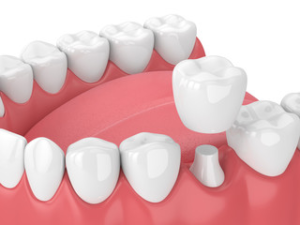A dental crown is a tooth-shaped cap that covers damaged teeth. https://bocadentallasvegas.com/improve the appearance of a misshapen or severely stained tooth, but they can also strengthen weakened teeth.
Having a crown inserted typically requires a few visits to the dentist. This is because the natural tooth needs to be filed down and a mold taken using a putty-like material. Visit https://bocadentallasvegas.com/ to learn more.

Porcelain crowns are tooth-shaped ‘caps’ that your dentist places over a damaged or weakened tooth to restore its shape, size, strength, and appearance. They are usually placed on front teeth to enhance your smile and improve your self-confidence. However, they can be used to strengthen any tooth, especially the molars (back teeth).
Dental crowns can be made from different materials depending on your needs and budget. Traditional porcelain crowns are a popular choice because of their natural look and translucent properties. They can be bonded directly to the tooth or layered over a core of other materials like Zirconia (see point #2 below).
There are several reasons why you might need a crown, such as a fractured or broken tooth, deep decay, large fillings or a root canal. There are two types of porcelain crowns – complete porcelain and porcelain fused to metal (PFM). PFM crowns have a tooth-colored layer baked onto a metallic base. In the past, these crowns were not regarded as strong or durable as other types of crowns, but recent advances in ceramic composition and bonding technologies have improved their strength and durability.
Your dentist will prepare the tooth by filing it down across the surface and sides (if necessary) to make space for the crown. This process can be slightly uncomfortable, and you will feel a sensitivity around the area for a few days afterwards. Fortunately, the procedure is performed under local anesthesia and topical numbing agents.
The dentist will then take an x-ray to examine the tooth structure and check that the crown will fit correctly and securely. They will then take impressions of the tooth or teeth, either with a traditional putty-like material or digitally via a handheld scanner. These impressions will be sent to a lab where the crown will be custom made for you.
The x-rays and impressions will allow the lab technician to create a crown that looks and feels just like your natural tooth. The type of crown you get will depend on your specific needs and budget, but they can be created from a variety of materials including traditional porcelain, empress, procera, lava, zirconia and emax.
Metal crowns are a popular restoration option for the back of your teeth because they provide strength and durability. They are fabricated from one-component materials and offer superior longevity and biocompatibility. Typically, they are made of base metal alloys that contain semi-precious and non-precious metals. They are often plated with other metals like nickel-chromium to enhance corrosion and tarnish resistance. Metal crowns are not a good choice for your front teeth because they can cause the surrounding teeth to become darker due to their metallic color. In addition, they are a poor choice for patients with severe habits like tooth grinding and jaw clenching because the metal can break or chip easily.
They are also less aesthetically pleasing, especially as they age and wear down. The underlying metal can show through the gum line, creating a dark shadow that is noticeable in your smile. This is why many dentists choose to use porcelain-fused-to-metal (PFM) crowns rather than metallic crowns for their patients. They provide the strength of a metal crown with the natural appearance of a porcelain one, but they can still chip or fracture.
Another concern with metal crowns is that they can corrode over time, exposing the underlying dentin and causing the tooth to weaken. Stainless steel crowns are the lowest quality and can be more visible than other crown types. For this reason, reserves them for baby teeth that do not need to last a lifetime.
If you decide that a metal crown is the best solution for your tooth, we will need to remove a large amount of healthy tissue to ensure that the crown fits well. This can make it more expensive than other options, but dental insurance coverage may cover a portion of the cost. Before making a decision, consider your aesthetic expectations, the location and function of the tooth, the price range for the type of restoration you prefer, and the dentist’s recommendation. If you have any questions or concerns about the process, ask our team for guidance. We are here to help you achieve a healthier, more functional smile!
Zirconia is an increasingly popular option for tooth crowns because of its confirmed perks. These include the ability to hide bad discoloration, fractures, and other tooth damage in a natural-looking way. They are also incredibly strong, which makes them ideal for back teeth. Zirconia is also biocompatible, meaning that it doesn’t cause any allergic reactions in the mouth.
Zirconium is a hard and durable type of crystal that can be manipulated into different shapes. This allows for a more natural-looking tooth shape that is able to withstand the pressures of chewing and bruxism. Additionally, zirconia can be made with a translucent surface that mimics the appearance of real teeth. This allows for a beautiful smile that looks like your natural teeth.
When compared to porcelain-fused-to-metal (PFM) restorations, zirconia crowns are stronger and more durable, and they don’t have any metal substructure. As a result, less of the original tooth needs to be removed in order for the crown to fit. This is especially beneficial to patients who are sensitive or allergic to metal.
Solid zirconia crowns contain more stabilizers than other types of dental ceramics, and as a result they are extremely strong and durable. They are able to withstand the heavy forces of mastication and bruxism much better than other dental materials. They also offer more fracture resistance and are virtually indestructible.
However, milled monolithic zirconia is opaque and doesn’t provide the same tooth-like translucency as natural teeth. This is why manufacturers have developed a process of coating monolithic zirconia with other material blends to create the esthetic look that many patients desire.
When it comes to making and placing zirconia dental crowns, dentists need to follow a certain set of guidelines to ensure the best results. This includes using a special putty to make an impression of the tooth that will receive the crown, and removing less of the natural tooth than with PFM or porcelain. Additionally, it is important that the dentist properly prepares the tooth for the crown by ensuring that all sharp angles and edges are rounded off and that the gingival margins are a minimum of 0.6 mm in depth and a maximum of 1.5 mm in width.
The CEREC crown process is a fast and effective method for restoring teeth. Using this computer-assisted technology, your dentist can design and create a dental crown in one visit. This is possible because the restorations are made of a durable ceramic material. The material also resists cracking and chipping, making it much more durable than other dental materials.
The procedure starts by numbing and preparing the tooth that needs to be restored. This involves removing any decayed or weakened tooth tissue and making sure the crown will fit correctly. Then a 3D camera scans the prepared tooth. This image is used by the design software to create a model of the tooth. This model is then passed to a milling machine that carves the dental restoration from a block of ceramic. The entire process is done in the dental office without the need for an impression.
Another advantage of the CEREC crown is that it has a more precise fit. This reduces small gaps that can allow bacteria to grow, leading to gum disease and tooth decay. The crown is also less likely to fall out, which could cause discomfort or damage the tooth.
As with any other dental treatment, the cost of a CEREC crown will vary. However, it is important to note that some insurance providers do cover the procedure at least partially. This is because it is generally considered medically necessary to treat large cavities or following a root canal.
If you are interested in getting a CEREC crown, contact us to schedule an appointment with our dental team. We will be happy to answer any questions you may have and determine whether this type of restoration is right for you.





